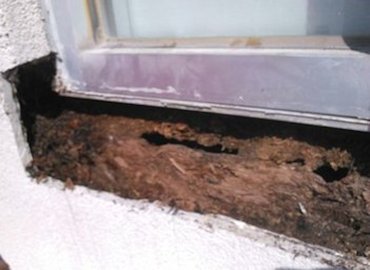REAL Stucco
in Alexandria, Virginia
Here's how we did it:

Work by the competition was torn off and re-done. One coat stucco with a synthetic finish was completely unappropriate
on this historic 1804 house. Check out the metal control joint. These weren't invented until the 1950's.

Area below the window is level creating a water funnel. Water soaks into the one coat stucco and will create rot.

You may remember a job we did like this before. Please click here to see it. 5 year old stucco installation caused severe rot.
The framing under the window was wet and felt like oatmeal.

We cut the two by four off under the window to allow room for an angled sill. Note the water streaks. This stucco was
9 months old.

Peel and stick rubber and aluminum flashing was tucked under the window jamb.

Sides and top of window are sealed with protecto wrap.

Offensive one coat stucco garbage is ripped off.

The competition used flat lath instead of self-furring. Wall had a thin basecoat and was covered with EIFS cloth
and EIFS basecoat, for some strange reason. A cornerbead made for interior use was used.

Wall was brought down tight to the slab and even sealed with caulk, trapping water that should drain out of the wall.

Weeps are used at the bottom of the wall to allow any water that penetrates the stucco to exit.

We used two layers of tarpaper.

Window returns are done by setting wood strips with a string line.

Wall is filled in between the strips and rodded off.

After wall is set up, returns are done by nailing strips and filling in the sides.

Window surrounds and details are formed using styrofoam. Don't worry, the foam is temporary. Metal lath is
nailed up with a magnet and stub nails.

The band is formed with two inch styrofoam and filled. We used white portland because it sets fast and is super hard.

I got the idea for the sills from the nearby Community Church of Old Town, which was built in 1804 also,
and has some incredible stucco work. Too bad some twisted minded person coated the building with synthetic finish.

We formed the sides with 1 1/2" foam and the sills with 2 inch foam.

A view of the finished sill. Note the steep angle for good water run off.

The band on the garden house was formed with 2 inch foam board.

Round window was formed using correx cut into 1 - 1/2" strips and filled in a little at a time.

Round window surrounds filled in waiting for the finish coat.

Bands and details are coated with an off white color finish.

Details are taped off and finish mortar applied to the wall.

The sand for the finish coat is crushed quartz from US Silica.

Color is yellow oxide paint colorant mixed in a garbage can.

Finished garden house.

Finished addition.




























